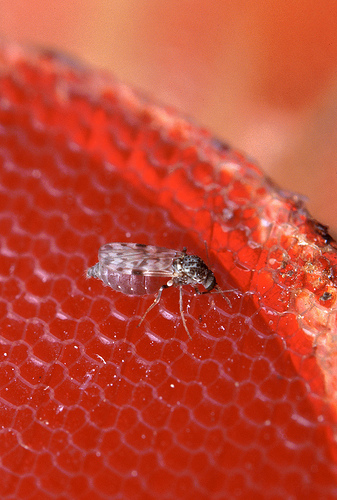Biting midges are awful irritators – or amazing, depending on the way you look at it.
- Biting midges are flying insects that are considered pests due to their habit of consuming human blood, and they are also known as ‘no-see-ums’, ‘midgies’, ‘midges’, ‘punkies’, and somewhat incorrectly as ‘sandflies’, although they are a technically a fly.
- Ceratopogonidae, is the family of biting midges, while those in the Culicoides genus number greater than one thousand, and they are generally found in areas near water or in mountainous regions.
- There are more than 200 biting midges in the Culicoides genus, the most common found in Australia, and they are native to moist, muddy or mass-vegetated habitats often in coastal areas, particularly those in northern Australia (especially the tropics), although other midges in the genus are found around the world.
- The size of a biting midge is extremely small, ranging from 1 to 3 millimetres (0.04 to 0.12 inches) in length and the insect consumes nectar from plants as part of its diet.
- Some biting midges cause significant irritation in humans after biting, which is caused by chemicals in the insect’s saliva, although not all midges are human pests; and it is often thought that their urine is what creates the burning irritation on one’s skin, however this is false.
A Biting Midge
Image courtesy of U.S. Department of Agriculture/Flickr
- Blood is collected only by female biting midges, to supply adequate nutrients for egg reproduction, and for this reason, males are harmless.
- The larvae of biting midges moult four times with the final time being the pupa stage, emerging as an adult two to three days later, with the entire process taking 3 to 22 weeks according to species, and it can also be dependent upon the moon and tide cycles.
- Biting midges are generally most active at dawn and dusk, when the females tend to bite, but they can also be a pest during the night and occasionally in overcast weather, however, they are generally less active when it is windy, and more active around full and new moons.
- The bites of biting midges are typically itchy and/or painful, and red swelling may be evident and grow to multiple centimetres in diameter, depending on one’s immunity, which can build over time, and unlike mosquitoes, midges in Australia are not known to spread disease among humans, though disease spread among animals and humans in other countries is evident.
- Biting midges tend to stay low to the ground, so they are not typically a pest in high-set buildings, and humans are best protected from their bites by being fully covered by clothing, with the addition of chemical insect repellents on uncovered areas, while the consumption of vitamin B1 (as suggested by some) is ineffective.
Bibliography:
Biting Midges, 2015, Merck Manuals, http://www.merckvetmanual.com/mvm/integumentary_system/flies/biting_midges.html
Biting Midges or “Sandflies” in the NT, 2003, Northern Territory Government, http://www.education.nt.gov.au/__data/assets/pdf_file/0014/3713/BitingMidge.pdf
Biting Midges or Sandflies, 2009, Government of Western Australia, http://www.public.health.wa.gov.au/cproot/2658/2/biting%20midges%20or%20sandflies.pdf
Culicoides spp., 2013, University of Florida, http://entnemdept.ufl.edu/creatures/aquatic/biting_midges.htm







